
Army plans to follow Navy, Air Force in outsourcing much of its IT infrastructure
The Army, over the next two years, plans to fundamentally reshape the way it delivers IT on its bases with an "as-a-service" delivery model.
Best listening experience is on Chrome, Firefox or Safari. Subscribe to Federal Drive’s daily audio interviews on Apple Podcasts or PodcastOne.
When it comes to its enterprise network, the Army has reached the same conclusion the Navy did almost two decades ago: Keeping pace with technology is likely to be a losing battle unless it offloads some proportion of the work to private industry.
So over the next two years, the Army plans to start moving itself toward a model it calls Enterprise-IT-as-a-Service, in much the same way the Navy consolidated its IT infrastructure into the Navy-Marine Corps Intranet in 2001.
As of now, the Army estimates that 70 percent of the servers, routers and end-user devices on its 288 worldwide facilities are at or near the end of life. The figure is even higher for the equipment that handles voice communications — about 90 percent.
Lt. Gen. Bruce Crawford, the Army’s chief information officer, said under the service’s current modernization methodologies, replacing all of that gear would take until at least 2030. And in the meantime, it would be stuck with the bills involved with maintaining an enormous amount of legacy infrastructure.
“It’s almost like a Gordian Knot we’re trying to untie when you look at the effort to modernize the enterprise,” he told an audience at the Association of the U.S. Army’s headquarters in Arlington, Va. this week. “The Army’s enterprise network, at its current level of investment, cannot meet the immediate and future warfighting requirements to optimize force readiness.”
IT infrastructure upgrade projects
In a request for information the Army issued to industry in January, it asked for feedback on two possible structures: One in which the Army’s infrastructure is owned by the government but operated by contractors, and one in which contractors both own and operate the infrastructure.
Crawford said the Army is planning three pilot projects to test out the enterprise IT-as-a-service (EITaaS) model this year, with six-to-eight more likely to follow in 2020. The first pilot will be at the new Army Futures Command in Austin, Texas.
The details of the projects are still being worked out, but he said the overall objective is less about saving money than about delivering more effective IT services.
“There are really three principles to our enterprise as a service model, and I expect our industry partners to hold us to this,” he said. “Principle number one involves enabling the Army to deliver IT at a commercial standard or better, to increase the pace of modernization and our ability to do what we do best for the nation, which is to project power forward around the world. The second principle is putting ourselves in a position where we can continuously leverage industry best practices, but doing that at scale. And third, optimizing to better defend the Army network’s mission systems and data.”
The Army’s decision to start to outsource at least some aspects of the management of its IT infrastructure makes it a latecomer of sorts among the military services.
Related Stories
But the Navy adopted a contractor-operated approach nearly 20 years ago in order to start to untie the same type of “Gordian Knot” Crawford is facing now.
The Navy came to regret some aspects of the contractor-owned-and-operated approach it started with, and it took until 2013 before it moved to a government-owned but contractor-operated structure that gave it more control over its IT assets and insight into the cost of individual network services.
Crawford said the Army is doing all it can to learn from the experiences of its sister services.
“We spent a lot of time thinking about this. The Navy came in and literally gave us every lesson they’ve learned. The Air Force came in, and they have several pilots they’re starting … a couple of which we are looking to actually flight-follow and partner with the Air Force on in FY 2020,” he said.
Cloud migration
In a separate, but related effort, the Army is taking new steps to speed up its adoption of cloud computing, even as the fate of the Defense Department’s JEDI Cloud contract remains uncertain.
Crawford said the Army remains fully supportive of the JEDI effort, but within the next three months, it will stand up a new cloud program office. After that, the Army is likely to create at least two contracts to help migrate existing systems to the cloud.
In 2019, the Army plans to focus its cloud transitions in five specific areas: intelligence data, financial management applications, global force integration, logistics and maintenance, and data at the tactical edge.
“We’ve spent some time thinking about this particular problem set, and I think we’ve gleaned a lot of insights in our market research from the likes of Netflix, Airbnb, the banking industry and other government organizations over the past six months,” Crawford said. “The most insightful recommendations have been that you need to start small and focus your cloud efforts on targeted, specific problems while you learn and build the capacity as an institution to migrate to the cloud at scale.”
Copyright © 2024 Federal News Network. All rights reserved. This website is not intended for users located within the European Economic Area.
Jared Serbu is deputy editor of Federal News Network and reports on the Defense Department’s contracting, legislative, workforce and IT issues.
Follow @jserbuWFED




